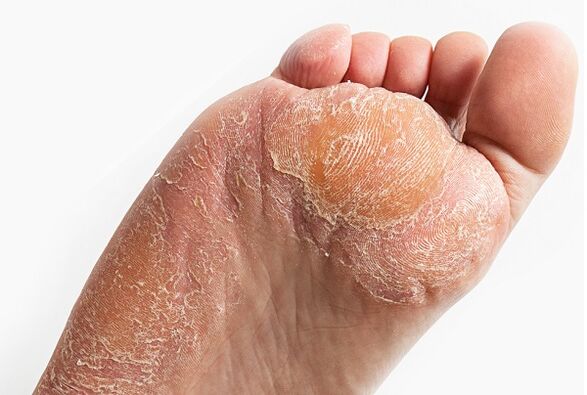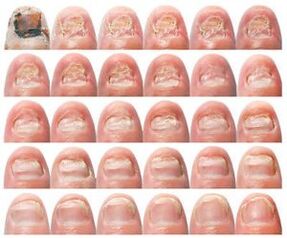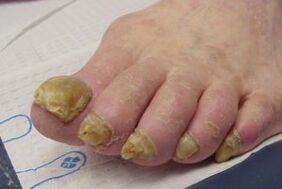Nail fungus, the symptoms of which are discussed below, most often occur due to disregard for personal hygiene rules. The symptoms of nail fungus are sudden in most patients, as the infection occurs almost unnoticed and immediately. Because treatment measures for this disease continue for a long time, it is better for a person who notices signs of the disease on their nails to see a doctor immediately.

Factors contributing to the development of the disease
The lesion may be caused by yeast, mold or skin fungi. In the first case, it is impossible to diagnose the disease immediately. Symptoms of the disease appear 5-6 months after infection. Exfoliation of the nail, mild irritation of the skin around it develops. Sometimes the patient suffers from severe itching.
In case the disease is caused by a fungus, three scenarios are possible:

- The skin on the feet, nails and feet is infected. The fungus can spread not only on the skin of the lower limbs, but can also catch on the fingernails.
- Another type of mycelium affects only the fingernails of the thumb or little toe. Sometimes such fungi pass through the folds between the fingers. It then touches the skin either 1-2 folds or all at once.
- Another type of disease - fungi are limited to the "occupation" of the nail plate on the little finger or thumb of the lower limb, but do not spread further.
- The last type of infection is mold. This type of mycelium usually occurs in people with severe immune system disorders such as HIV.
In all cases, the onset of the infection is due to the following reasons:
- The protective properties of the patient's body decreased below critical levels.
- The nail is mechanically damaged.
- The man was wearing too tight shoes. The blood circulation in the legs was disturbed, leading to an infection.
- Some people have anatomical pathology of the foot that contributes to the formation of fungi.
- Most often, patients diagnosed with obesity suffer from the disease. The disease leads to excessive sweating. This creates favorable conditions for mycelial development.
- In diabetics, fungi develop.
To prevent illness, use only your clothes, shoes and personal hygiene items. It is recommended to disinfect and clean carpets and shoes in time.
General signs of the disease

The first signs of nail fungus appear on most people in the form of small whitish dots or streaks on the nails. Most people don’t pay attention to this as nothing hurts him, there is no discomfort. If you do not start treating mycosis in time, you can start the disease. On all the nail plates, the mycelium germinates and the skin begins to swell around the affected nails. In severe cases, the disease spreads to deep tissue structures. This threatens the development of necrosis and amputation of the foot or even the entire foot.
In the second stage of mycosis, the natural light on the nail plates disappears. The color of the nails changes. Yellow with brown or white stripes. The upper part and side surfaces of the nail are often deformed. Such changes are clearly visible to the eye.
In the last stage of the disease, the nail plates become very fragile, the inflammatory process begins in the cuticle. One can completely lose one's nails. But mushrooms don't stop here. They continue to spread to all the nail plates and then to the skin of the foot, i. e. they capture the feet.
The patient himself recognizes the disease in the second and third stages because the nails are yellow or brown (sometimes blackened). The nail rises from its bed, its fragility increases, it breaks quickly.
Symptoms of the disease in the initial stages
If someone has developed nail fungus, the symptoms of the disease are virtually absent at first. But then, 2-3 months after penetrating the skin fungus and fixing it on your nails, you may notice the following signs of the disease:
- A slight reddening first appears on the surface of the skin near the affected plate.
- The person then feels a burning sensation in this area.
- Severe itching develops and inflammation begins.
- Subsequently, areas with increased humidity develop in these areas.
- The nail thickens and keratinizes.
As soon as a person notices these signs of nail fungus, they should be examined and then treatment should be started.
Depending on the type of fungal infection, in the subsequent stages of mycosis, the patient's nail plate is stained with different colors. In the first stage of the disease, the affected area may turn white or green. The spots on it are located along the surface or appear as round dots. However, in most patients, the thickness of the plate does not change, and in many cases the nail retains its natural shine. The itching is very strong in all cases, it is not possible to get rid of it immediately. If the patient notices signs of mycosis in time, he or she can get rid of the burns and itching by using medications such as miconazole, clotrimazole, and the like. But it should not be treated on its own, it is better to do it under the supervision of a doctor. In the event of any errors or failure to follow your doctor’s recommendations, the mycelium will immediately spread to healthy areas, making treatment difficult.
Later development of the disease
Nail fungus, if left untreated, can deprive your nails of their natural color and the surface of the affected area will turn yellow. There is a detachment of the nails. They may begin to break down. However, the patient causes intolerable itching of the skin around the affected area. The cracking of the nail plate material begins. The burn is increasing. Some patients may develop dysbacteriosis, feel unwell, and complain of weakness throughout the body. Maybe the development of drowsiness.

First, the mycelium completely changes the surface color of the plates and then begins to thin. The diseased nail is then rejected and the infection penetrates the structure of the skin. The itching gets worse.
In the last stage of the disease, the surface of the diseased nail plates becomes scaly. Depending on the fungus that hit the person, the nails begin to thicken and peel off. They break quickly. The symptoms of the disease are as follows:
- The edges of the plates become very fragile. Sometimes this causes pain in the patient.
- The shape of the plates is strongly distorted, and a scaly surface may form.
- The color of the affected area changes from yellow to black.
- The insertion of parts of the plates into the skin begins.
- A whitish or yellowish coating appears under the nail. This is due to their peeling off the bed.
- The itching is very strong, almost unbearable. The burning sensation of the skin around the affected areas increases again.
If these symptoms appear and treatment is started on time, it will take a long time. A disease can become infected in 4-5 seconds and the disease is very difficult to cure. This usually takes 3-6 months. Discontinuation of treatment is not recommended due to possible complications that may lead to surgery. So listen carefully to yourself. If the initial symptoms are detected and treatment is started immediately, it is possible to complete the therapy more quickly while sparing your nails.






























